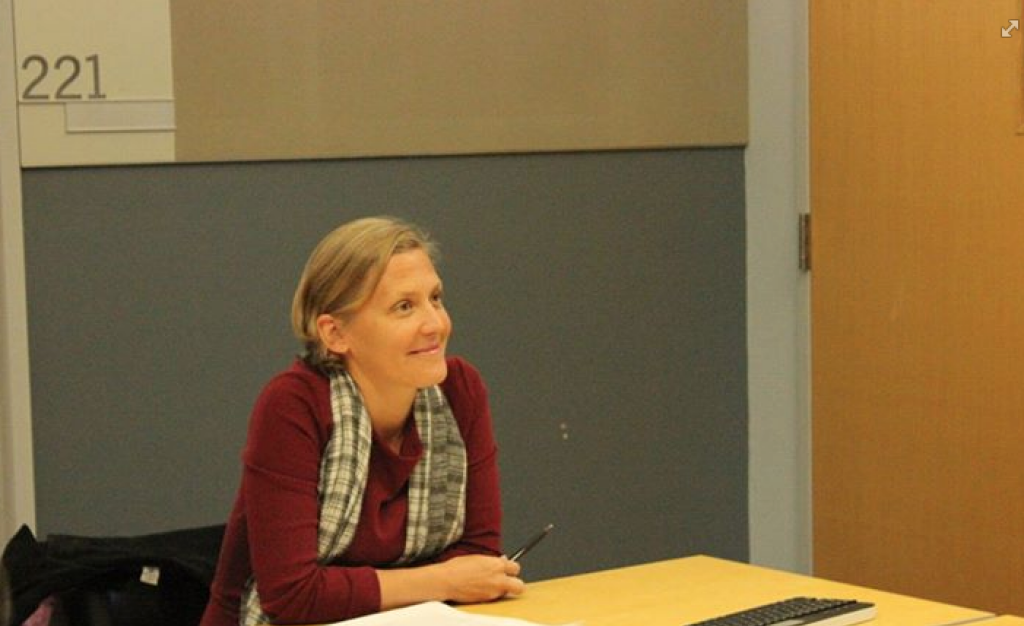Watch the video of the event here
On Oct. 31 the Jordan Center welcomed Dr. Juliane Fürst, Senior Lecturer at the University of Bristol, to speak about her most recent book project, entitled “Love, Peace and Developed Socialism: A Short Course in the History of the Soviet Hippie Movement and its Sistema.” NYU Professor Eliot Borenstein introduced the guest speaker, highlighting Fürst’s last major publication Stalin’s Last Generation: Soviet Post-War Youth and the Emergence of Mature Socialism (Oxford University Press, 2010). He added that she recently turned to the study alternative cultures in the late Soviet Union, with special attention paid to hippie communities.
Fürst began her talk by stating that the subject of the Soviet hippies is a “tema incognita”; very few people in the country actually knew about hippie communities. At times, she said, the hippies themselves did not quite know about their own culture. The frequent use of pseudonyms within the community presented yet another challenge to Fürst’s research. “I tried to reconstruct what actually happened to the hippies. Separate myth from fact and put it into historical context,” Fürst added.
The hippies came about in the Soviet Union in the late 1960s. While most of them organized their communities either in Moscow, Leningrad or the Baltics, there is evidence nevertheless of their presence as far east as Magadan and Irkutsk. Fürst presented a photograph that depicted a hippie slogan “Luchshe rabotat’ zavtra, chem segodnia» (Better to work tomorrow than to work today). This slogan, Fürst explained, is an inversion of a communist slogan. By this example, Fürst highlighted that the hippies were in a constant dialogue with the official rhetoric: “they could not really escape each other.”
The hippie community, Fürst believes, is very important to the study of late Soviet culture. While the hippies were a visible group in the 1970s and 80s because they often purposefully congregated in prominent public spaces in their cities, their story hardly entered narratives about late socialism. In this way, the hippies reflect and define that period: they reflect Soviet mechanisms of exclusions and simultaneously “give parameters of what was possible in late Soviet Socialism.”
Fürst began her inquiry by asking how a hippie becomes a hippie. Many stated that they could not explain “what came over them,” claiming that there was “simply something in the air.” For the rare few, it was a “eureka moment.” In reality it was usually a combination of external and internal influences: “of course for most people it was a more gradual process of alienation from the mainstream life.” For many, it all started with music. For others, it started by being identified as a hippie by the authorities.
This identification did not start off on a negative note. The Soviet media played a significant role in introducing the American hippies to the Soviet community in a rather positive light. For example, the 1967 article in Pravda identified them as a group of young people with anti-American, anti-Vietnam, anti-bourgeois values. The 1968 article in Vokrug Sveta entitled “Khozhdenie v stranu Hippliandia” (“A trip to the Country Named Hipplandia”) “became a program for the hippie movement.” It described children who have fallen out with their parents because they hated growing up in a bourgeois culture.
The first wave of hippies was indeed a community largely made up of urban and privileged children of elites, who were better connected to the West and therefore had more potential to kick start a hippie movement. Among them was even Joseph Stalin’s son, Vasily, as well as the children of the Mikoyan family. “One can see how in one family, the roads divide.”
However, Fürst demonstrated that the families did not necessarily divide on political fronts by discussing an incident that occurred in 1968 while the Prague Spring was in full blow. Several members of the hippie community attempted to sneak into the Czech embassy – mainly to enjoy a selection of foreign music, books, and films that was stored there and not available elsewhere in the country. During this temporary “occupation,” “not a word was exchanged about what was happening in the Prague Spring,” Fürst added. This episode reveals the “shift away from thaw generated non-conformism. Here non-conformity is happening on a different level.” The hippie hallmark, Fürst suggested, was breaking out from a community that was more intellectual to one that was more visible; instead of explicit political dissent, they liked to occupy visible spaces and to consume alternative culture and in this way “directly challenging the monopoly of the mainstream.”
Maintaining a particular aesthetic and consuming particular culture was central for the hippies. Their preferences in music and self-image, together with their political activities differed from the activists of the Thaw generation. “One cannot exaggerate the importance that the Beatles played in the hippie movements and in general in alternative movement formations.” Fürst asserted that the Beatles started to symbolize the cult of sincerity that went beyond the official rhetoric. “It was an escape from the world that did not feel sincere anymore – one where there was too much cynicism.”
The next part of Fürst’s talk was dedicated to the gradual process of unification of hippies into what they termed a “sistema.” When in the early 1970s the Russian hippies began to travel to the Baltics, encountering other people like themselves gave them a desire to “have a larger missionary purpose and a larger community.” You could no longer be a hippie in isolation. At this time, the officials identified the local hippies and began to recognize them as a certain nuisance. Several walks in Moscow in 1969 and in 1970 resulted in clashes with the police; during the second walk which included over several hundred participants, many were arrested for 15 days or conscripted to the army a year later for two to three years. This was a watershed moment for the hippie movement in Moscow. Until then, the hippie movement was made up of students. After that event – it became clear that “you could not be a student and a hippie.” A serious segregation was taking place; now, “if you were a hippie, you were outside society.”
The hippies were now “searching and probing all sorts of directions where they could find greater anchorage,” whether it was found in esotericism, mysticism, Russian orthodoxy, Tolstoyanism, or drugs (while the main Moscow group was heavily into drugs, it was not true for all groups in the Soviet Union). The “sistema” also began to organize rituals for their own community. For example, travelling to a summer location became a central event for a Soviet hippie. It had “something to do with the idea of freedom,” Fürst remarked; in the repressive and geographically limited Soviet Union, the hippies devised their own miniature symbolic mapping of the world (i.e. going to the Baltics signified going to little Europe, while a trip to Central Asia was often seen as a trip to Shangri-La).
Despite their attempt at unification and autonomy, Fürst revealed, the Soviet regime and its official rhetoric ensured the existence of the hippie community. During perestroika a lot of the activities that largely defined the hippies as part of the “underground” became legal currency; by 1988, people no longer saw the sense in the “sistema.” Fürst’s research shows that rather than a contradiction, the hippie community and the Soviet Union during late socialism was a symbiosis; the “sistema” could only exist against the background of late socialism. It needed a bland space in order to project on it its own vision. By the mid 1990s, “the ‘sistema’ learned in a harsh way that even though it survived the Soviet Union, it could not live without it.”
Fürst’s talk was followed by several questions. Professor Jane Burbank asked a question about the interconnection of the hippies to other underground artistic communities. Fürst responded by saying that it is a complicated question: the hippies were all linked to a larger “underground.” However, “underground” at times goes “overground,” she explained. Sometimes, members of various underground communities met and crossed paths in psychiatric hospitals when detained for their non-conformist activities. In Leningrad – where the hippie scene was different from Moscow’s – there was more interaction with other groups because many of them spent time at the hub of alternative culture – the infamous Saigon café on Nevsky Prospekt.
Fürst also pointed out that some members of the “sistema” created art; while it is undeniable that some of them had talent, they nevertheless had no outlet where they could further develop their skills. She added that the hippies explicitly rejected the written word; very consciously, they did not want to participate in the samizdat culture. They often referred to themselves as apolitical and saw political dissidents as pursuing a useless cause. At times, they even revealed an open hostility to dissidents. Fürst sees this complete rejection of the system as its complete acceptance. “They were conformist in their non-conformism.”
Fürst was also asked to differentiated between hippies and “stilyagi.” She said that it is a misconception to see them as the same group; while the “stilyagi” reacted to post-war poverty through an exaggerated form of consumption, the hippies reacted against “bourgeoisfication.” And while there is currently an increasing nostalgia for “stilyagi” in mainstream media, the “hippies are still a counterculture to official culture today.”
Finally, Fürst was asked to comment on the interrelationship between the hippies and the homosexual community. She replied that the hippies were negative, at times even violently aggressive towards homosexuals. She said that it is hard to tell whether they provoked such reaction because they saw them as abnormal or because at the time, they were engaged in criminal acts. “When I ask if there were homosexuals in the hippie movement, the answer is always no.”



